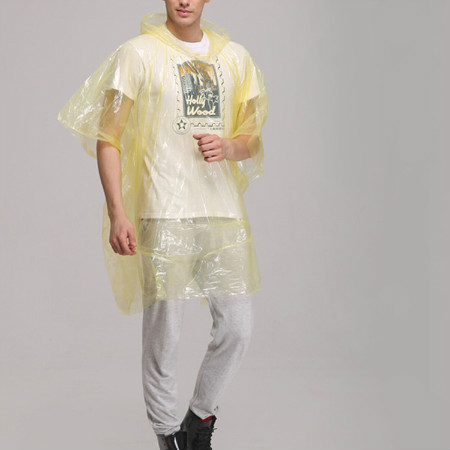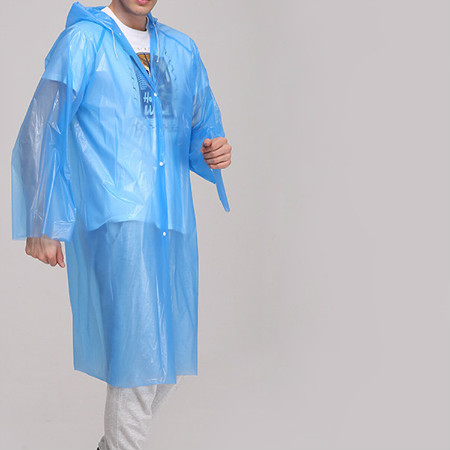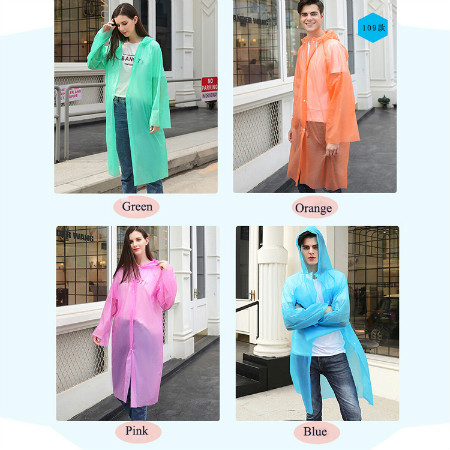Raincoats are rain-proof clothes made of waterproof fabrics. Suitable waterproof fabrics include tape, tarpaulin and plastic film.
Raincoats originated in China. During the Zhou Dynasty, some people used vanilla "Lit Li" to make raincoats to protect against rain, etc. This kind of raincoat is often referred to as "fungi". Modern raincoat waterproof fabric pays attention to breathability. Breathable raincoats help people to evaporate hot and humid moisture from the raincoat when wearing them, increasing comfort.

The raincoat originated in China. In the Zhou Dynasty, some people made raincoats with vanilla "Fu Li" to prevent rain, snow, wind, and shade. This kind of raincoat is what people often call the "Princess". Around the Spring and Autumn Period, the ancients had invented a kind of tarpaulin raincoat. "Twenty-seven Years of Zuo Zhuan·Ai Gong" contains: "Chen Chengzi Yi Makes a Stick Ge". Du pre-note: "system, raincoat". Duan Yucai of the Qing Dynasty believes that making rain gear is not a grass-made rain gear. According to research, at that time, people already knew about the dry oil plants like tung and fern. The so-called tarpaulin is a rainproof cloth that is coated with tung oil or cui oil on the fabric and dried. After the Northern and Southern Dynasties, the production of tarpaulin raincoats went a step further. It can be processed on silk or made of cocoon paper. In the Sui Dynasty, tarpaulin was used to make raincoats. The Book of Sui Dynasty once stated that Emperor Yang of Sui Dynasty watched the hunting and met the rain, "into the oil coat from left to right". However, this tarpaulin raincoat is expensive to make, and it is difficult for ordinary people to obtain it. Only the nobles can enjoy it. The raincoat of the Tang Dynasty was a combination of a raincoat and a hat. Tang Zhangzhi and the phrase in "The Fisherman" said: "The green raincoat, the green raincoat, the oblique wind and drizzle do not need to return." This truly describes the working people wearing raincoats to work. . So "green chopsticks" and "green clothes" are said, because both are made of plant leaves, and there were raincoats made of silk in the Tang Dynasty. For a long period of time in history, princess clothes and hats are still popular raincoats, but with the development of social productivity, they are no longer thatch, but replaced by brown, and the production is becoming more and more exquisite. In the Song and Yuan dynasties, the princess was a raincoat for army soldiers. During the Ming and Qing Dynasties, the nobles also preferred to wear hats, such as Jia Baoyu in "A Dream of Red Mansions", wearing a "Jade Needle" made from jade and grass on rainy days, and a "Golden Rattan" made of thin strips of rattan bark and brushed with tung oil. ", aroused the admiration of the girls. As rain-proof clothing, the princess has been used until the emergence of modern new plastic raincoats and gradually disappeared from people's vision. However, in some remote mountainous areas, you can still see the fur clothing made of plant fibers.
In 1747, French engineer François Freno used the latex obtained from rubber wood to put cloth shoes and jackets in this latex solution for dipping treatment, which can play a waterproof role. In a rubber factory in Scotland, England, there was a worker named McKindus. One day in 1823, McKindus accidentally dripped rubber solution on his clothes while working. After he found it, he quickly wiped it with his hands. Who knew that the rubber liquid seemed to seep into the clothes, and instead of wiping it off, it became a piece of paint. McKindus was reluctant to discard this dress, so he still wore it to get off work. Soon, McKindus discovered that the rubberized area on the dress seemed to be coated with a layer of waterproof glue. Although it looked ugly, it was impervious to water. He simply coated the entire garment with rubber, and as a result, he made a garment that can keep out rain. With this new style of clothing, McKindus no longer has to worry about rain. This novelty spread quickly. After the colleagues in the factory knew about it, they followed McKindus's approach and made waterproof tape raincoats. Later, the reputation of the tape raincoat became more and more popular, which attracted the attention of British metallurgist Parkes, who also studied this special clothing. Parks discovered that although the rubberized clothes were impervious to water, they were hard and brittle. They were neither beautiful nor comfortable to wear. Parks decided to make some improvements to the clothes. It was not until 1884 that Parkes invented the technology of using carbon disulfide as a solvent to dissolve rubber to make waterproof products, and applied for a patent. In order for this invention to be quickly applied to production and transformed into a commodity, Parkes sold the patent to a person named Charles. After that, raincoats began to be produced in large quantities, and the business name of "Charles Raincoat Company" quickly became popular all over the world. However, people have not forgotten the merits of McKindus. Everyone calls the raincoat "McKindus." Since then, the word "raincoat" has been called "Mackintosh" (mackintosh) in English. After entering the 20th century, the appearance of plastics and various waterproof fabrics made the styles and colors of raincoats increasingly richer [1]. After the 1960s, raincoats made of plastic film or treated raincloth became popular.

Craftsmanship
According to the fabric
Modern society often uses raincoats made of plastic film or treated rain-proof cloth. This type of raincoat has the advantages of easy production, lightness and softness, many varieties of patterns and low prices [2]. There are many kinds of raincoat fabrics commonly used in life, including nylon Oxford cloth, coated fabrics, polyester fabrics, PTFF (polytetrafluoroethylene), Gore-Tex fabrics, etc., but for outdoor sportsmen, the raincoat fabrics need to be comfortable. , Breathability.
Tape: The rubber of the raincoat is attached to the cotton cloth, which is soft, thick and firm.
Rainproof cloth: Two clothes, good waterproof performance, but more fragile than thin hair.
Plastic: The raincoat is easy to carry, has good water resistance, and is inexpensive, but the service life is not long [5] [6].
Oxford cloth: a fabric made of cotton or polyester through a specific weaving method. It is easy to wash, quick-drying, soft to the touch, good moisture absorption, soft color of the fabric, soft body, good air permeability, comfortable wearing, and two-color effect.
Coated fabric: The inner surface of the fabric is coated with a layer of waterproof and moisture-permeable paint, such as raincoats commonly used by police and climbers, which have better waterproof and breathable effects, but the price is high.
Polyester fabric: The biggest advantage of the fabric is that it has good wrinkle resistance and shape retention, but it has poor dyeability and poor moisture absorption and breathability.
PTFF (Polytetrafluoroethylene): Lightweight and comfortable to wear, good waterproof and breathable performance, and low price. First used in the production of military uniforms and protective clothing, and then used in sportswear. The manufacture of tents and other items is also an excellent material for biochemical protective clothing.
Nylon: The product has good gloss, strong strength and good abrasion resistance, but it is easy to deform under the action of external force, so its fabric is prone to wrinkles during wearing.
Gore-Tex: Windproof, rainproof, comfortable, and breathable. It is composed of film and high-performance textile fabric, and is sealed with a new type of adhesive, which can provide long-lasting waterproof protection.
According to the style
The main styles of raincoats include: cloak type, H type, split type, one-piece type, double riding raincoat, etc., which need to meet the different needs of outdoor sportsmen and suitable for different sports environments. Take the double raincoat for cycling as an example. The sleeve structure is designed with zippers, which makes it easier to put on and take off on the basis of conforming to the human body structure and arm comfort; the double raincoat can be split into a single raincoat, which can be quickly separated if there is an emergency during riding, so that the rider The safety factor of the raincoat has been improved; in the design, the concealed buckle will be used to make up for the integrity and practicality of the raincoat in a single state, so that the raincoat has a good rainproof effect when it is split into a single state; harmonious color matching can improve Viewability can also ensure that cyclists are more easily observed under low visibility conditions, thereby improving safety. Therefore, fluorescent yellow, fluorescent red or vibrant orange are used more, and it is also convenient to carry and store.
Process analysis
As for the craftsmanship of raincoats, the common raincoat sewing technology on the market uses overlock stitching, which is less comfortable to wear and cannot completely prevent the infiltration of rainwater. Therefore, computer high-pressure PU heat-sealing processing technology can be used to widen the heat-sealing belt, which can effectively prevent rainwater from infiltrating through the pinhole seam and enhance the rainproof effect of the raincoat.
Dress style
Precautions
1. After the raincoat is exposed to water, lift the collar and gently shake off the water droplets. Do not wipe it with your hands or towel to prevent the rainproof performance from being reduced. After the water drops shake, place it in a cool place to dry. It will be 80 to 90% of the time. You can keep the waterproof performance after ironing it with an iron. When storing, it should be dried without squeezing.
2. After the raincoat is drenched, it should be dried in a cool place. Do not expose to the sun and fire to prevent the glue layer from becoming sticky. Normally, do not come into contact with oil, nor wash with gasoline, dry it when storing, preferably sprinkle some talcum powder. Pay attention to frequent inspections, if there is adhesion, it should be spread out and dried in time.
3. The plastic raincoat should only be cleaned with a soft cloth after raining. Do not expose it to the sun or fire it. Generally, it is not necessary to wash it with excessive alkaline soap. If a plastic raincoat is wrinkled, it can be soaked in hot water at 80°C for one or two minutes to eliminate the wrinkles. If you find any cracks or holes, you can repair it yourself. First cut a piece of plastic cloth larger than the hole to cover it, put a thin wire mesh (or wooden board) under it, and iron it with a hot soldering iron. The hole or crack can be glued. Close. After the plastic raincoat is cracked, do not sew it with stitches, otherwise the hole will become bigger and bigger.
Dress etiquette
Raincoats are special-purpose clothing. Not only can they effectively prevent rain, they are also more convenient to use than umbrellas, so they are very popular. When wearing a raincoat, pay attention to the following points:
1. When visiting relatives and friends, take off the raincoat and put it in the bathroom after entering the door, or give it to the host to put it in an appropriate place. It is impolite to get wet with the host’s clothes if you hang it casually.
2. When taking public vehicles or taxis, you must take off your raincoat. It is also immoral for people to squeeze in the crowd with wet raincoats for their own convenience.
3. When shopping in the store, you should try not to lean on other customers to avoid getting other people's clothes wet; if there are many customers in the store, you should take off your raincoat if you want to stay in the store for a long time.
4. When you go to a public place to watch movies, plays or visit an exhibition, you should store your raincoat like a coat. If there is no storage area, you should take off the raincoat and fold it in a proper place. Try not to Let the rain seep.
Social hierarchy mark
In American society, the color of the raincoat is a significant sign of social hierarchy.

The main function of raincoats is to prevent people from getting wet by rainwater, which will affect people's health. The number of users of raincoats in China is quite large, and the southern region is particularly typical. The climate in the southern region is a subtropical monsoon climate, with a long rainy season, with a lot of precipitation in a year, and the amount of precipitation is quite large. Umbrellas are also commonly used rain shields, but in heavy rain and strong winds, pedestrians will be soaked by the rain on the road and often cause symptoms such as colds, burns, and typhoid. Therefore, in addition to umbrellas, almost every household in the south will have raincoats as waterproof clothing for traveling on rainy days. The times are advancing, but the alternation of the four seasons and the changes of the weather have been operating in their own law, unaffected by human activities. People still need rainwear to protect themselves when traveling in rainy weather. Therefore, rainwear has always maintained its functionality, and its design prospects have a relatively broad development space.


